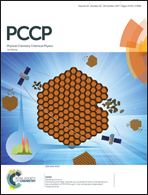Complexation of β-cyclodextrin with dual molecular probes bearing fluorescent and paramagnetic moieties linked by short polyether chains†
Abstract
Electron paramagnetic resonance (EPR) and fluorescence spectroscopies provide molecular-level insights on the interaction of paramagnetic and fluorescent species with the microenvironment. A series of dual molecular probes bearing fluorescent and paramagnetic moieties linked by flexible short polyether chains have been synthesized. These new molecular probes open the possibility to investigate various multi-component systems such as host–guest systems, polymeric micelles, gels and protein solutions by using EPR and fluorescence spectroscopies concertedly. The EPR and fluorescence spectra of these compounds show that the dependence of the rotational correlation time and fluorescence quantum yield on the chain length of the linker is not linear, due to the flexibility of the polyether linker. The quenching effect of the nitroxide moiety on the fluorescence intensity of the pyrene group varies with the linker length and flexibility. The interaction of these dual molecular probes with β-cyclodextrin, in solution and in polymeric gels, was evaluated and demonstrated by analysis of EPR and fluorescence spectra.



 Please wait while we load your content...
Please wait while we load your content...